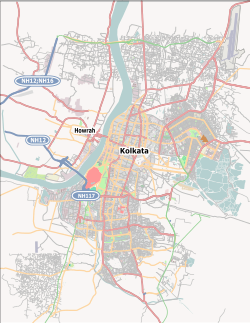Fort William, India
| Fort William | |
|---|---|
| Kolkata, West Bengal, India | |
 Fort William, a view from the inside, c. 1828 | |
| Coordinates | 22°33′28″N 88°20′17″E / 22.5577°N 88.3380°E |
| Type | Fortress, garrisoned and armoured Army Headquarters. |
| Site information | |
| Controlled by |
|
| Site history | |
| Built | 1696–1702 |
| In use | 1781–present |
| Battles/wars | Battle of Plassey (1757) |
| Garrison information | |
| Garrison | Eastern Command |
Fort William is a
The fort was named after King William III.[1] In front of the Fort is the Maidan, the largest park in the country. An internal guard room became the Black Hole of Calcutta. Today the fort is the headquarters of Eastern Command of the Indian Army.
History


There are two Fort Williams. The original fort was built in the year 1696 by the
Today, Fort William is the property of the Indian Army. The headquarters of Eastern Command is based there, with provisions for accommodating 10,000 army personnel. The Army guards it heavily, and civilian entry is restricted.[4]
Much of Fort William is unchanged, but St Peter's Church, which used to serve as a chaplaincy centre for the British citizens of Kolkata, is now a library for the troops of HQ Eastern Command.
A war memorial has been created at the entrance of the fort, and the fort also houses a museum which displays artifacts from the
First Indian Masonic lodge
In 1730, Ralph Farrwinter and other members of the
Presidency of Fort William
Structure
The Fort is built of brick and mortar in the shape of an irregular octagon with an area of 5 km2 (1.9 sq mi). Five of its sides face landward, and three towards the
Gallery
-
Fort William, 1735
-
Fort William, by Jan Van Ryne, 1754
-
Fort William, Calcutta, 1756[11]
-
First English Chapel, Fort William, Calcutta. Raised in 1714, with contribution of Rs. 1000 by the East India Company (p. 197, March 1824)[12]
-
St Peter's Church, Fort William by William Prinsep 1835
-
Fort William, River Face 1786 (from a coloured engraving by Thomas Daniell).
-
The interior of the Arsenal, Fort William by William Prinsep 1835
-
Fort William by Samuel Davis
-
Main entrance, Fort William 2013
-
South gate, Fort William 2013
-
St. Peter's Church, Fort William, Kolkata
-
Semaphore Tower, Fort William, Kolkata
-
Main Gates of Fort William
See also
References
- ISBN 9781902669595.
- ^ Sudip Bhattacharya, Unseen Enemy: The English, Disease, and Medicine in Colonial Bengal, 1617 – 1847, Cambridge Scholars Publishing, 30 Jun 2014, p.54
- ^ "Fort William Kolkata India - History of Fort William". www.makemytrip.com. Archived from the original on 10 April 2019. Retrieved 27 December 2018.
- ^ ISBN 81-230-1002-8.
- ^ "History | Directorate of Ordnance (Coordination and Services) | Government of India". Ddpdoo.gov.in. Archived from the original on 19 January 2022. Retrieved 11 August 2022.
- ^ "Memories of 1971 Bangladesh War come alive in Army museum". Economic Times. 16 December 2013. Archived from the original on 27 December 2022. Retrieved 11 June 2020.
- ^ "Indian Army to throw parts of Eastern Command HQ open for public". Economic Times. 17 December 2013. Archived from the original on 25 December 2022. Retrieved 11 June 2020.
- OCLC 7288589062. Archivedfrom the original on 28 March 2021.
- ^ Joseph F. G. Golder. Freemasonry in British India (1728–1888). Archived from the original on 28 March 2021.
- ^ Nandakumar Koroth, History of Forts in North Malabar
- ^ Grant, James (1873). British Battles On Land and Sea. Vol. II. Cassell & Company, Limited. p. 69.
- ^ "The Gentleman's Magazine, and Historical Chronicle". The Gentleman's Magazine, and Historical Chronicle. 94 (1): 197. February 1824. Retrieved 13 December 2017.




![Fort William, Calcutta, 1756[11]](http://upload.wikimedia.org/wikipedia/commons/thumb/7/70/Fort_William%2C_Calcutta.jpg/120px-Fort_William%2C_Calcutta.jpg)
![First English Chapel, Fort William, Calcutta. Raised in 1714, with contribution of Rs. 1000 by the East India Company (p. 197, March 1824)[12]](http://upload.wikimedia.org/wikipedia/commons/thumb/9/93/First_English_Chapel%2C_Fort_William%2C_Calcutta._Raised_in_1714%2C_with_contribution_of_Rs._1000_by_the_East_India_Company_%28p._197%2C_March_1824%29.jpg/120px-First_English_Chapel%2C_Fort_William%2C_Calcutta._Raised_in_1714%2C_with_contribution_of_Rs._1000_by_the_East_India_Company_%28p._197%2C_March_1824%29.jpg)








